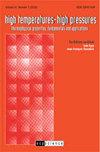用均匀微扰模拟研究弱外力对复杂液体导热性的影响
IF 0.6
4区 工程技术
Q4 Engineering
引用次数: 0
摘要
采用改进的evans - gillan均匀摄动格式测量了强耦合尘埃等离子体(scdp)的热响应和相应的归一化等离子体导热系数λ0。采用均匀微扰分子动力学(HPMD)方法进行效率分析,并与平衡分子动力学(EMD)方法计算的微扰热通量矢量结果进行比较。我们的新结果表明,在非常低的归一化外部扰动(F*)值下,通过HPMD和EMD方法获得的热能流热响应非常一致。所得的HPMD仿真结果表明,该方法具有收敛速度快、系统尺寸小的优点,适用于弱F*下的中低等离子体耦合(Γ)。结果表明,在接近平衡弱F*(= 0.00005)下,等离子体λ0的测量结果与EMD、均匀和非均匀非平衡分子动力学模拟和理论预测的结果基本一致,并且根据等离子体参数的排列,等离子体λ0一般高估了~1% ~ ~24% (Г,本文章由计算机程序翻译,如有差异,请以英文原文为准。
Studies of weak external force on thermal conductivity of complex liquids using homogenous perturbed simulations
A modified Evan-Gillan homogenous perturbed scheme was employed to measure the thermal response and corresponding normalized plasma thermal conductivity (λ0) of strongly coupled dusty plasmas (SCDPs). Homogenous perturbed molecular dynamics (HPMD) approach was employed to analyze the efficiency and compared the obtained outcomes of perturbed heat flux vector to the outcomes computed through equilibrium molecular dynamics (EMD) approach. Our new outcomes show that the thermal response of heat energy current through HPMD and EMD approaches is an excellent agreement with each other for SCDPs at much low value of normalized external perturbation (F*). The obtained HPMD simulations demonstrate that the presented approach provides good outcomes with fast convergence and small system size for low-tointermediate plasma couplings (Γ) at very weak F*. It was found that the measured plasma λ0 outcomes at nearly equilibrium weak F* (= 0.00005) are in reasonable agreement with earlier results obtained from EMD, homogenous and inhomogeneous nonequilibrium molecular dynamics simulations and theoretical predictions and generally overpredicted the plasma λ0 by ~1%–~24% depending on the arrangement of plasma parameters (Г, к). It was shown that the HPMD is an excellent approach to calculate the plasma λ0 and to recognize the elementary patterns in 3D SCDPs.
求助全文
通过发布文献求助,成功后即可免费获取论文全文。
去求助
来源期刊

High Temperatures-high Pressures
THERMODYNAMICS-MECHANICS
CiteScore
1.00
自引率
9.10%
发文量
6
期刊介绍:
High Temperatures – High Pressures (HTHP) is an international journal publishing original peer-reviewed papers devoted to experimental and theoretical studies on thermophysical properties of matter, as well as experimental and modelling solutions for applications where control of thermophysical properties is critical, e.g. additive manufacturing. These studies deal with thermodynamic, thermal, and mechanical behaviour of materials, including transport and radiative properties. The journal provides a platform for disseminating knowledge of thermophysical properties, their measurement, their applications, equipment and techniques. HTHP covers the thermophysical properties of gases, liquids, and solids at all temperatures and under all physical conditions, with special emphasis on matter and applications under extreme conditions, e.g. high temperatures and high pressures. Additionally, HTHP publishes authoritative reviews of advances in thermophysics research, critical compilations of existing data, new technology, and industrial applications, plus book reviews.
 求助内容:
求助内容: 应助结果提醒方式:
应助结果提醒方式:


